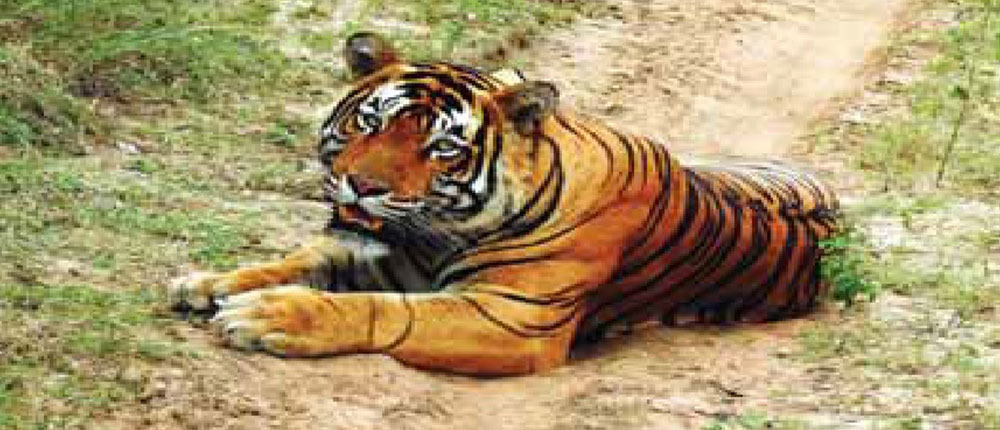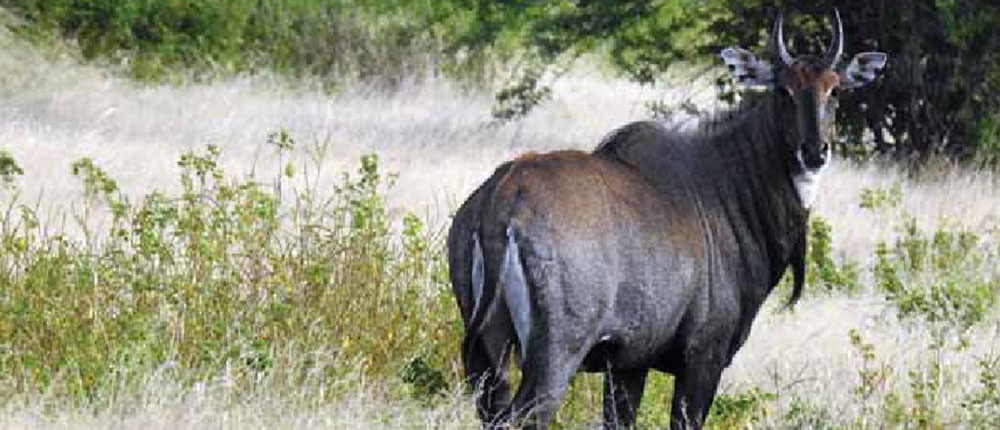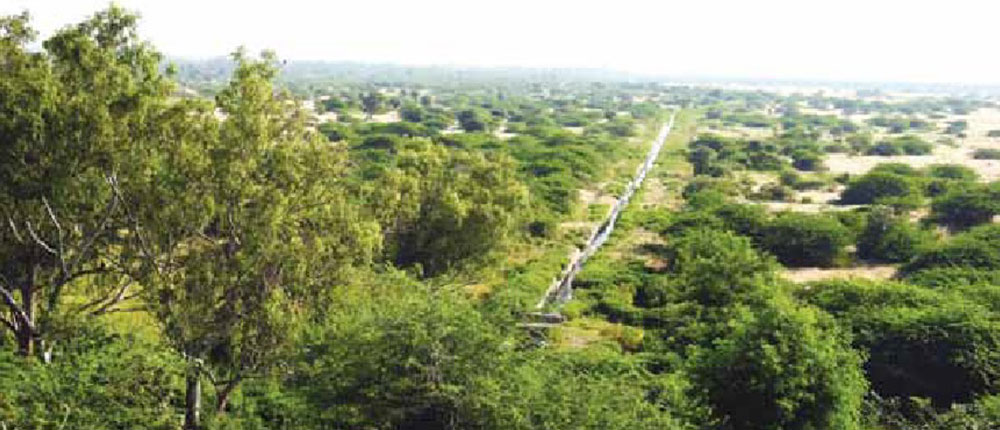The big cat is India's pride but its dwindling population is a serious concern today. In this piece, the author writes about his observations on the behavioural ecology of tigers in the Mukundara Hills Tiger Reserve (MHTR) — Rajasthan's recently established tiger reserve and gives suggestions for the successful management of the reserve.
The patch of hill bamboo near Foot-talab in Mukundara Hills Tiger Reserve (MHTR) was green, dense and cool. The rampant growth of vegetation in that location had blocked the forest road in many places and so, with great difficulty, we drove and tried to be on the trail of the radio-collared robust young male tiger, known as MT1.
The very strong signal from the radio-collar indicated that the tiger was somewhere nearby in the cool patch of the bamboo (Dendrocalamus strictus) not far from where our vehicle was. The encounter was unexpected and the tiger emerged from the bushes and came as close as one metre from the vehicle! Silently, it retreated into the bush, about four metres from us, lay down, and watched us intently. We were five of us on that open vehicle and we observed the tiger without distracting it at all. After some time, we left it in peace and drove away.

An Interesting Behaviour of the Tiger
This tiger, when it dispersed into the Ramgarh Wildlife Sanctuary from Ranthambore Tiger Reserve, was caught and released in the 80 km2 enclosure of MHTR on 3 April 2018. During summer, when the day-time temperatures hovered around 47°C, this tiger gave greater importance to thermoregulation by avoiding the heat of the day by seeking refuge in cooler places that are not many in the enclosure.
During the initial days of its release, the tiger would spend most of its time in a deep nallah known as Junapani in a well-shaded area which has a well-like cavern but no water. The nearest water hole is Foot-talab, about 500 m from Junapani. Although the staff could not spot the tiger, they came to know of its presence in Junapani from the radio signals. In May-June, MT1 spent most of its time in the proximal part of the Similia canal which had water coming from the Sawan-Bhado reservoir. The canal below the reservoir bund is more like a tunnel.
At night, the animal wandered around looking for prey and everyday, entered the tunnel early in the morning and stayed there till the early hours of the night. On 28 May 2019, as darkness was setting in, it was seen emerging out of the tunnel. There was a massive adult nilgai bull feeding near the tunnel entrance and the tiger, with an astonishing agility, leapt and caught the bull by its throat, bringing it down within a few minutes. This behavioural instinct of the tiger of spending weeks in one place during day-time to avoid the oppressive heat could be the first recorded pattern in the behavioural ecology of the tiger. Otherwise, tigers even when they are on a kill, spend only a few days in and around the kill.
The Reserve
MHTR was established on 9 April 2013, after the notification from the Rajasthan Government, although the notification by National Tiger Conservation Authority had come on 15 December 2010. It is the 42nd tiger reserve in the country and has an area of 760 km2 (core 417 km2 and buffer 343 km2) in the Vindhyan Range, extending between the Chambal and Kali Sindh rivers. It encompasses the Mukundara National Park, Darrah Wildlife Sanctuary, Jawahar Sagar Sanctuary, and parts of Chambal Sanctuary which form the core, and some other territorial forests of Kota, Chittorgarh, and Jhalawar forest divisions, which constitute the buffer. Currently, MHTR is an isolated reserve as its contiguity with Ranthambore Tiger Reserve along the forests of Dabi-Bundi-Ramgarh Wildlife Sanctuary-Sawai Madhopur Wildlife Sanctuary is broken by large-scale open mining activities in the Dabi forests. Also, connectivity with Ranthambore Tiger Reserve along the Prosopis juliflora-dominated narrow and long forests on the banks of Kali Sindh River may not be continuous.
Another concern is the non-stop heavy traffic of trucks, buses, and other vehicles that ply at all hours along National Highway 12 (Jaipur to Jabalpur) and every day, nearly 150 passengers and goods trains speed along the Delhi- Mumbai broad gauge rail tracks. Both the road and the rail tracks cut across the reserve for nearly 6 km and contribute to the break in the reserve into a northern part and a southern part.
It should be noted that the reserve management has already identified three locations where overpasses for animals across the railway track could be built and the authorities are hopeful that the section of the road cutting across the reserve shall be lifted as a flyover in the future. The overpasses and the space below the flyover can link the northern and the southern parts of the reserve for the large mammals to move across. Further, within the tiger reserve, there are about 30 villages, and around the reserve, within a belt of 5 km, there is a minimum of 100 villages. The livestock and the number of people in and around the reserve could be in the order of 100,000 each.
The villagers, living largely below the poverty line, eke out their living in a landscape that receives a meagre annual average rainfall of c. 700 mm in July, August, and September. These villagers are heavily dependent on their livestock – goats, sheep, cattle, and buffalo – for survival. Naturally, immense biotic pressures are felt by the reserve as it is nearly 80 km long and 3–5 km broad; as a result, it was very difficult to find an area within the reserve that was totally free from biotic pressures such as grazing and wood cutting.

Building the Enclosure
In this scenario, an appreciable, far-sighted conservation effort has gone into the building of the 80 km2 enclosure in the southern part of the Darrah Wildlife Sanctuary, with no village inside, by building a 2.5 m high wall with 1.2 m high inclining chain-link fence on the top for 28 km, and a chain-link fence of 4.5 m in height for 27 km. The cost incurred was close to Rs 30 crore.
The enclosure could not be built in the northern part of the sanctuary as there are some villages where the inhabitants are reported to be aggressive. They did not approve of constructing either a wall or a fence that would block them from entering the forest. Although, water for construction was available only near Darrah forest rest house, it is remarkable that the construction of the fence, which involved about 1200 labourers, was completed within a short period of three-and-half months (January–mid-April 2018). Mohan Raj, the divisional forest officer, who did a commendable job, was very happy about this achievement.
One of the biggest challenges for the forest personnel was convincing the local villagers about the need for the fence. Traditional migratory grazers known as rebari would come with hundreds of sheep from July to September and graze their cattle in the area where the enclosure has now been built. There are proposals to extend this fencing to cover an area of about 200 km2, which will hopefully support a minimum of six adult tigers.
Survey and Findings
I had the opportunity to carry out a rapid survey within the enclosure from 6 October to 10 October 2018, and I stayed at the British-era Darrah forest rest house, which has been beautifully renovated recently. Assisted by the officials of the forest department, I drove for 125 km within the enclosure to evaluate the habitat and record the number of large ungulates seen.

The habitat within the enclosure can broadly be divided into a flat c. 25 km2 northern area, which comprises the Sawan-Bhado reservoir, and a hilly tract covering the rest of the area. The eyesore in this flat area is the presence of numerous enclosures with broken rubble walls built in the past to protect patches of land from grazing. The vegetation in the dry part of the flat area is dominated by short grasses (e.g., Aristida adscensionis and Digitaria stricta) and by tall grasses (e.g., Heteropogon contortus, Themeda triandra) in the moist shallow areas. By far, Apluda mutica seems to be the most abundant tall grass in the dry tracts of the hills. Abundance of thorny Prosopis juliflora, an exotic variety, is a problem in the moist areas.
The hilly tract has an abundance of Anogeissus pendula, an excellent forage species for ungulates but, sadly, as a result of intensive grazing activities in the past, the understorey is dominated by American mint, (Hyptis suaveolens) a strong-smelling weed which significantly reduces the quality of the habitat for wild ungulates.
Other prominent inedible plants are Cassia tora and Lantana camara. Unpalatable species such as Achyranthes aspera (inedible after fruiting), Martynia annua, Peristrophe bicalyculata, and Xanthium strumarium, although not that abundant, were also identified during my stay.
My drive, covering an area of 125 km, resulted in the sighting of nearly 80 nilgai, which is the most common wild ungulate within the enclosure, 40 chinkara, 10 wild pigs, 5 chital near the soft-release enclosure, and 2 sambar does near Bewda talai. While on the drive I saw large number of cattle within the enclosure which had been abandoned by the villagers. These cattle can serve as a buffer prey enabling the wild ungulate numbers to increase. Some langur groups were also seen in the hilly area. The sambar is a heavily poached wild ungulate not only in India but also throughout its range in Asia.
The hilly terrain in most parts of the enclosure with an abundance of A. pendula gives the hope of reviving the sambar population in the enclosure. Well-protected hills with sufficient suitable forage species can support a high population of sambar, as seen in the hills of Rajaji Tiger Reserve, Uttarakhand. I also saw many nilgai females, each with three calves, and for G V Reddy, the chief wildlife warden who accompanied me, said, he had not beheld such a sight anywhere else in Rajasthan.
What Is the Way Forward?
After my stay, I shared a few suggestions with the forest department. There is great potential to have a population of about 100 blackbucks in the flat area in the north. A few are reported to occur, which, however, were not seen by me. The blackbuck, a meadow-habitat dependent species, can peacefully coexist with chinkara, a browser presently found in the flat area, and both the antelopes would add immense charm to the tiger reserve. Suitable methods should be employed to capture about 20 blackbucks from the Sorsan Grasslands, not far from the enclosure, and released to augment the population in the enclosure.
The rubble walls, an eyesore, should be removed with the help of an agreement with the owner/s of the stone crushing factory functioning in the Kanwas Village on the border of the enclosure. The stones that are used to build the rubble walls could be given to them for free or if they are willing, they could be requested to donate money to the Mukundara Hills Tiger Foundation. Otherwise, the stones could be used when the wall fencing is extended to cover an area of 200 km2 of the reserve.
Involving the villagers and using machines like JCB, the forest department could effectively address the menacing proliferation of P. juliflora to significantly reduce its occurrence in the enclosure. But one should remember that it is going to be a challenging issue as the deeprooted P. juliflora is a tenacious species. One should explore all possible means of eradicating/controlling the abundance of P. juliflora.
Cutting and cool-season burning could be used wherever C. tora and H. suaveolens occur in clumps in the grasslands. Tall grass Themeda triandra patches seen in the moist part of the northern area should be subjected to cool-season burning so as to get protein rich sprouts, which could be immensely beneficial to the ungulates. Special efforts are needed to convert the C.tora-dominated habitat near Foot-talab into an excellent short grass (meadow) habitat. Removal of C. tora could be a harrowing task but it should be followed by efforts to grow grass in the area.
Fruits of many forest trees are exceedingly important for wild ungulates. The two Ficus species that are extremely beneficial to frugivorous birds and wild ungulates are Ficus religiosa and F. bengalensis and both need to be grown in tree holes using either seedlings or cuttings. If grown on ground, the young plants could be killed by ungulates unless they are protected by an ungulate-proof fence. It is interesting to note that almost all ficus trees we see in the forest have their origin from tree holes.
Other fruit-bearing forage species that can be grown are Aegle marmelos, Garuga pinnata (can grow along nallahs), Gmelina arborea, Grewia tiliifolia, Phyllanthus emblica, Terminalia bellirica (only very few old trees are seen in the enclosure), and Ziziphus mauritiana. I was told that the nursery could be established near the Sawan-Bhado reservoir. It is a possibility that the abundant thorny P.juliflora couldbeusedto buildungulate-proof fences around the saplings/cuttings of the aforementioned species when planted.
It is most likely that even the Ranthambore tigers could be inbred as they are reported to have grown to the present number of over 60 from a small population of about a dozen animals. Two females from Ranthambore Tiger Reserve have been already released in the enclosure.
Once the enclosure is extended to 200 km2, new blood — a male and two females, preferably from Panna Tiger Reserve , where the population has a mixture of genes from different tiger habitats could be brought in.
I left MHTR with a wish and a prayer that this goal of having a small number of breeding tigers in the enlarged enclosure will have the blessings of the Rajasthan and Madhya Pradesh forest departments, National Tiger Conservation Authority, and the Ministry of Environment, Forest and Climate Change.
(Dr AJT Johnsingh's Acknowledgement: My gratitude to Valmik Thapar, G V Reddy, Ghanshyam Prasad Sharma, Mohan Raj, Urvasi Sharma, and the staff of the MHTR for their support and help which enabled me to accomplish this task. Special thanks are in order for Nandini Murali and Madhavi Sethupathi, who were the first readers of this article. I am grateful to Mervin Johnsingh, who edited the pictures that accompany this article; the article was first carried in the January 2020 issue of TerraGreen).
Dr AJT Johnsingh is a self-taught wildlife biologist from Tamil Nadu. He has been associated with Nature Conservation Foundation, WWF-India, and Corbett Foundation
